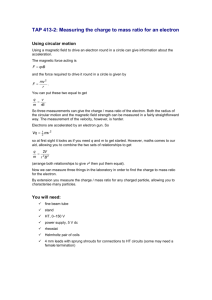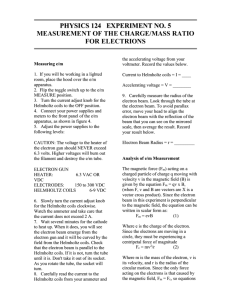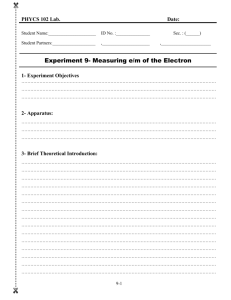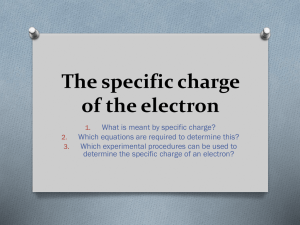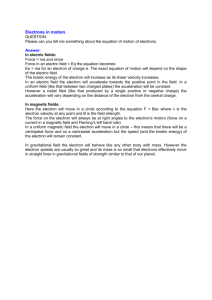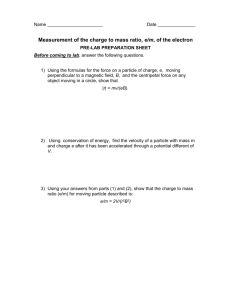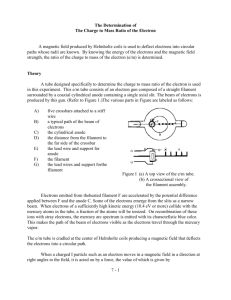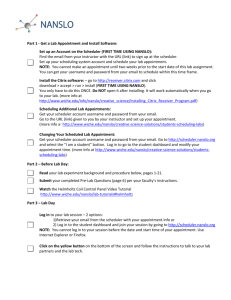Charge to Mass for Physics
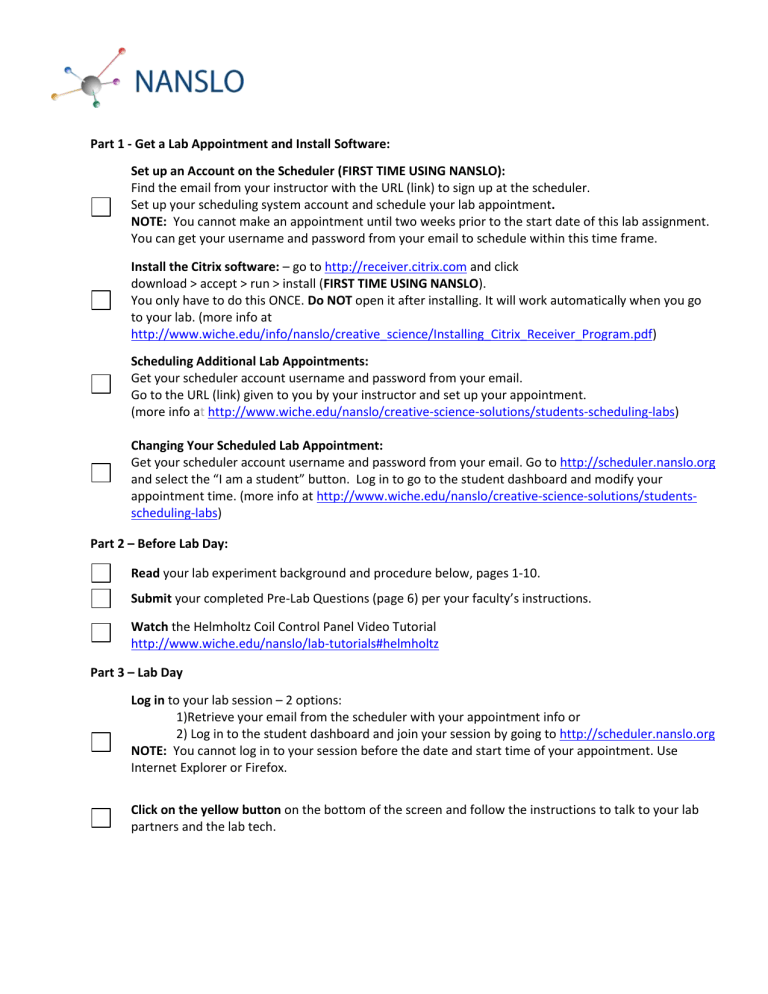
Part 1 - Get a Lab Appointment and Install Software:
Set up an Account on the Scheduler (FIRST TIME USING NANSLO):
Find the email from your instructor with the URL (link) to sign up at the scheduler.
Set up your scheduling system account and schedule your lab appointment.
NOTE: You cannot make an appointment until two weeks prior to the start date of this lab assignment.
You can get your username and password from your email to schedule within this time frame.
Install the Citrix software: – go to http://receiver.citrix.com
and click download > accept > run > install (FIRST TIME USING NANSLO).
You only have to do this ONCE. Do NOT open it after installing. It will work automatically when you go to your lab. (more info at http://www.wiche.edu/info/nanslo/creative_science/Installing_Citrix_Receiver_Program.pdf
)
Scheduling Additional Lab Appointments:
Get your scheduler account username and password from your email.
Go to the URL (link) given to you by your instructor and set up your appointment.
(more info a t http://www.wiche.edu/nanslo/creative-science-solutions/students-scheduling-labs )
Changing Your Scheduled Lab Appointment:
Get your scheduler account username and password from your email. Go to http://scheduler.nanslo.org
and select the “I am a student” button. Log in to go to the student dashboard and modify your appointment time. (more info at http://www.wiche.edu/nanslo/creative-science-solutions/studentsscheduling-labs )
Part 2 – Before Lab Day:
Read your lab experiment background and procedure below, pages 1-10.
Submit your completed Pre-Lab Questions (page 6) per your faculty’s instructions.
Watch the Helmholtz Coil Control Panel Video Tutorial http://www.wiche.edu/nanslo/lab-tutorials#helmholtz
Part 3 – Lab Day
Log in to your lab session – 2 options:
1)Retrieve your email from the scheduler with your appointment info or
2) Log in to the student dashboard and join your session by going to http://scheduler.nanslo.org
NOTE: You cannot log in to your session before the date and start time of your appointment. Use
Internet Explorer or Firefox.
Click on the yellow button on the bottom of the screen and follow the instructions to talk to your lab partners and the lab tech.
Remote Lab Activity
SUBJECT SEMESTER: ____________
TITLE OF LAB: Charge to Mass for Physics
Lab format: This lab is a remote lab activity.
Relationship to theory (if appropriate): This activity involves the investigation of how the motion of an electron is affected by the presence of a magnetic field.
Instructions for Instructors: This protocol is written under an open source CC BY license. You may use the procedure as is or modify as necessary for your class. Be sure to let your students know if they should complete optional exercises in this lab procedure as lab technicians will not know if you want your students to complete optional exercise.
Instructions for Students: Read the complete laboratory procedure before coming to lab.
Under the experimental sections, complete all pre-lab materials before logging on to the remote lab, complete data collection sections during your on-line period, and answer questions in analysis sections after your on-line period. Your instructor will let you know if you are required to complete any optional exercises in this lab.
Remote Resources:
Primary Equipment – Helmholtz Coil; Secondary Equipment – High
Voltage Power Supply
.
CONTENTS FOR THIS NANSLO LAB ACTIVITY:
Preparing for this NANSLO Lab Activity ........................................................ 6-7
Exercise 1: Qualitative Observation ............................................................. 8
Exercise 3: Data Analysis (Can be done off-line if necessary) ...................... 9
Exercise 4 (Optional): Advanced Analysis .................................................... 9
U.S. Department of Labor Information ......................................................... 10
1 | P a g e L a s t U p d a t e d M a y 2 6 , 2 0 1 5
LEARNING OBJECTIVES:
After completing this lab, you should be able to do the following things:
1.
Investigate how the motion of an electron is affected by the presence of a magnetic field.
2.
Measure the ratio of the electron charge to the electron mass: e/m a.
Control power supplies to optimize conditions for making measurements e/m b.
Calculate e/m from individual data points and average c.
Graph the measurements to determine the value of e/m d.
Compare the value of e/m from the graph to e/m calculated from individual data e.
Compare the value of e/m from the graph to the accepted value of e/m
3.
(OPTIONAL) Advanced Analysis a.
Determine the effect of Earth’s magnetic field on the path of an electron. b.
Relate the shape of an electron beam to its orientation in a magnetic field.
BACKGROUND INFORMATION:
( Adapted from materials created by the WASC project: http://rwsl.nic.bc.ca/ )
In this experiment, we will use a gas discharge tube and a pair of Helmholtz coils, as illustrated in Ошибка! Источник ссылки не найден., to examine the motion of electrons in a magnetic field. The Helmholtz coils produce a nearly uniform magnetic field over the entire gas discharge tube. When excited by collisions with electrons, the helium gas in the discharge tube emits light so we can see the path of the electrons
2 | P a g e L a s t U p d a t e d M a y 2 6 , 2 0 1 5
Figure 1: Helmholtz Coils with gas discharge tube showing electron path
When an charged particle, of charge q, mass m and velocity v , enters a uniform magnetic field
B , a force F
B
on the charged particle is created by the magnetic field interacting with the moving electron (Ошибка! Источник ссылки не найден.). This force is given by
F
B
q
(1)
The force direction is perpendicular to both the charged particle velocity and the magnetic field.
Figure 2: Force on a moving charged particle in a magnetic field (into the page)
3 | P a g e L a s t U p d a t e d M a y 2 6 , 2 0 1 5
The magnitude of the force is
F
B
qvB sin
(2) where
is the angle between velocity and the magnetic field.
In the case of an electron, charge
e , moving perpendicular to the magnetic field (θ = 90°), this simplifies to
F
B
evB (3)
The sign of the force is ignored here because we are only interested in the magnitude. We will assume that all other forces on the electron are negligible. An object under a net force that is perpendicular to its velocity will undergo circular motion with centripetal acceleration a c v
2
r
In this case, the net force is F
B
ma c
so, substituting terms,
(4)
(5)
In this experiment, electrons pass through two parallel plates as they enter the gas discharge tube. The potential difference between the plates is V. Assuming kinetic energy of electrons before entering the plates is negligible, the kinetic energy of the electrons after passing through the plates is
K
eV (6) or evB
m v
2 r
1
2 mv 2 eV (7)
We can rearrange equations (5) to isolate the velocity v
erB m and substitute this into the kinetic energy equation (7) to get
(8)
4 | P a g e L a s t U p d a t e d M a y 2 6 , 2 0 1 5
1
2 m erB m
eV or, with a bit of work,
(9) e
2 V
2 2 m r B
(10)
This shows that we can measure the ratio of the electron charge to the electron mass if we know the potential difference used to accelerate the electrons, the magnetic field strength, and the radius of the circular motion of the electron.
Depending on the magnetic field strength B and the accelerating potential V, the electrons can travel anywhere within the discharge tube. The Helmholtz coils produce a magnetic field that is constant to within 1%, and in the direction of the line joining the centers of the two coils, over the entire discharge tube. According to the manufacturer of the Helmholtz coil device we are using (NADA scientific), the magnitude of the Helmholtz coil magnetic field within the discharge tube is
𝐵 = (0.7155 ± 0.0001) (
4𝜋
10 7
) (
𝑁𝐼
𝑅
) (11) where I is the coil current, N is the number of coils, and R is the radius of the coils, both of which are constants.
Now, we can combine equations 10 and 11 to get an equation that we can collect data to satisfy in the experiment we’re about to do: 𝑒 𝑚
=
2𝑉 𝑟 2 𝐶 2 𝐼 2 where C is the combination of all the constants from equation (11).
(12)
References:
1.
Laboratory Manual for Principles of Physics I and II, 5 th Edition 2004, prepared by Jason
Diemer, North Island College.
2.
Nakamura e/m Apparatus Manual. NADA Scientific, N99-B10-7350
5 | P a g e L a s t U p d a t e d M a y 2 6 , 2 0 1 5
PRE-LAB EXERCISE:
1.
The accepted value of the charge/mass ratio of an electron is 1.758820088 x 10 11
Coulomb/kg (National Institute of Standards and Technology: http://physics.nist.gov/cgi-bin/cuu/Value?esme
). How close do you think your result from this experiment will be to
that value?
2.
What are the sources of uncertainty (error) in this experiment? How will they impact your result?
3.
Here are values you will need for your calculations. Calculate the value of C from equation (12), and estimate the total uncertainty contributed by these values: a.
N: 130 turns of wire b.
R: 0.0150 +/- 0.0005 meters
4.
Electrons are sub-microscopic, so how are you able to see them in this experiment?
EQUIPMENT:
Paper
Pencil/pen
Computer (access to remote laboratory
PREPARING FOR THIS NANSLO LAB ACTIVITY:
Read and understand the information below before you proceed with the lab!
Scheduling an Appointment Using the NANSLO Scheduling System
Your instructor has reserved a block of time through the NANSLO Scheduling System for you to complete this activity. For more information on how to set up a time to access this NANSLO lab activity, see www.wiche.edu/nanslo/scheduling-software .
Students Accessing a NANSLO Lab Activity for the First Time
For those accessing a NANSLO laboratory for the first time, you may need to install software on your computer to access the NANSLO lab activity. Use this link for detailed instructions on steps to complete prior to accessing your assigned NANSLO lab activity – www.wiche.edu/nanslo/lab-tutorials .
Video Tutorial for RWSL: A short video demonstrating how to use the Remote Web-based
Science Lab (RWSL) control panel for the Helmholtz Coil can be viewed at http://www.wiche.edu/nanslo/lab-tutorials#helmholtz .
6 | P a g e L a s t U p d a t e d M a y 2 6 , 2 0 1 5
NOTE: Disregard the conference number in this video tutorial.
AS SOON AS YOU CONNECT TO THE RWSL CONTROL PANEL: Click on the yellow button at the bottom of the screen (you may need to scroll down to see it). Follow the directions on the pop up window to join the voice conference and talk to your group and the Lab Technician.
EXPERIMENTAL PROCEDURE:
Read and understand these instructions BEFORE starting the actual lab procedure and collecting data. Feel free to “play around” a little bit and explore the capabilities of the equipment before you start the actual procedure. If you want to see the Helmholtz coils and discharge bulb, ask the Lab Technicians to remove the cover for you before you start the experiment. They will have to replace the cover before you begin the experimental procedure, however.
Summary of Experimental Procedure:
You will control the settings of an experimental apparatus similar to that depicted in Ошибка!
Источник ссылки не найден. to collect data with which you can solve for the charge/mass ratio of the electron using equation (10). The goal is to find a combination of voltage and current that will produce the best value of e/m.
1.
The electron emitter in the gas discharge tube must be heated for it to work optimally.
The control code won’t allow the application of the acceleration potential until the emitter is sufficiently heated, so turn the heater on first.
2.
Once you have turned on the pre-heater power supply, there will be a 100-second time delay before you can turn on the accelerating voltage power supply.
3.
You will be able to control the amperage sent to the Helmholtz coils and the accelerating voltage for the electron beam.
4.
The discharge from the gas in the tube is rather faint, so the camera views the discharge tube through a darkened cardboard tube.
5.
Once established, the electron ring will look like this:
Figure 3: Electron Ring
7 | P a g e L a s t U p d a t e d M a y 2 6 , 2 0 1 5
6.
Once you establish a ring of electrons in the discharge tube, you will use the scale on the control panel to measure the diameter of the electron ring. a.
Measure the outside edge of the glowing plasma ring produced by the electrons. b.
There is a glass rod inside the discharge bulb with a cm scale on it, but it is difficult to see, so use the scale with moveable slider that is on the control panel. c.
Use a square piece of paper or something similar to line up with the edges of the control panel on your computer screen and the outside edge of the left side of the plasma ring. d.
Move the slider on the scale under the video panel to coincide with the edge of your piece of paper. This will be the diameter of the electron beam.
7.
Ensure that each of your lab partners gets a chance to collect at least one set of data.
EXERCISE 1: Qualitative Observation
DATA COLLECTION:
1.
Set the electron acceleration potential difference to something between 250 and 400 V, and raise the Helmholtz coil current in steps. What happens to the electron beam?
Does this make sense with respect to equation (10)?
2.
Set the Helmholtz coil current to between 1.0 and 2.0 A, and raise the electron acceleration potential difference in steps. What happens to the electron beam? Does this make sense with respect to equation (10)?
EXERCISE 2: E/M Measurement
1.
Set the accelerating potential difference to between 200 and 500 V. Record this value and estimate its uncertainty.
2.
Adjust the Helmholtz coil current so the electron beam forms a circular path within the discharge tube. Measure the outside diameter of the electron beam. Record your measurements along with the coil current and the associated estimated uncertainties.
3.
Repeat step 2 for six different Helmholtz coil currents.
4.
Let another student take control of the control panel, change the accelerating potential
difference by at least 50 V, and repeat steps 2 and 3 for another set of radius
measurements.
5.
Other students should repeat step 4 for at least two more sets of data at different
voltages between 200 and 500 V.
6.
Make sure that each student in the group collects at least one set of data.
7.
Make sure that each student records all the data sets that are collected. You will have at least 4 sets of data; one each for the 4 different accelerating potential settings.
8.
Turn off the discharge tube accelerating voltage, then the Helmholtz coil power supply, in that order.
8 | P a g e L a s t U p d a t e d M a y 2 6 , 2 0 1 5
EXERCISE 3: Data Analysis (Can be done off-line if necessary)
1
Rewrite equation (12) with 𝑟 2 in terms of the other variables. We will treat dependent variable that depends on the independent variable I
2 𝑟
1
2 as the
. For each of your accelerating potential values, plot
1 𝑟
2
on the vertical axis versus
(insert a Trendline in Excel) for each set of data.
I 2 on the horizontal axis. Draw a best fit line
1.
If 𝑟
1
2
is the y-variable, and slope of the best fit line?
I
2 is the x-variable, what is the resulting expression for the
2.
How are the slopes of the best fit lines related to the ratio of e/m?
3.
For the data sets at each value of accelerating potential: a.
Solve for e/m using the values for each data point and equation (12) b.
Average the value of e/m from all 6 data points. c.
Calculate e/m from the slope of the best fit line of those 6 data points. d.
Compare the values from b and c to the accepted value of e/m. Which value is
closer to the accepted value? Does this make sense? Explain. e.
Which accelerating voltage potential setting produced the most accurate value of e/m? Does this make sense based on the background material? Explain.
EXERCISE 4 (OPTIONAL): Advanced Analysis
1.
In the analysis of this experiment, we ignored the magnetic field due to the Earth. Use the Internet to find an estimate of Earth’s magnetic field strength at the lab site
(Denver, CO). Estimate how and how much this affects a typical radius measurement.
2.
Describe the electron beam shape that would result from if we rotate the gas discharge tube so the beam is emitted with some component of its velocity vector in the same direction as the magnetic field (instead of perpendicular to it).
3.
Describe the electron beam if it is emitted in the same direction as the magnetic field. 𝑘𝑔∙𝑚 2
4.
In metric units, and Amp is a Coulomb/second, and a Volt is expressed as:
𝐴𝑚𝑝∙𝑠 3
Using metric units, show that equation (12) results in units of Coulomb/kg.
9 | P a g e L a s t U p d a t e d M a y 2 6 , 2 0 1 5
For more information about NANSLO, visit www.wiche.edu/nanslo .
All material produced subject to:
Creative Commons Attribution 3.0 United States License 3
This product was funded by a grant awarded by the U.S.
Department of Labor’s Employment and Training Administration.
The product was created by the grantee and does not necessarily reflect the official position of the U.S. Department of Labor. The
Department of Labor makes no guarantees, warranties, or assurances of any kind, express or implied, with respect to such information, including any information on linked sites and including, but not limited to, accuracy of the information or its completeness, timeliness, usefulness, adequacy, continued availability, or ownership.
10 | P a g e L a s t U p d a t e d M a y 2 6 , 2 0 1 5
